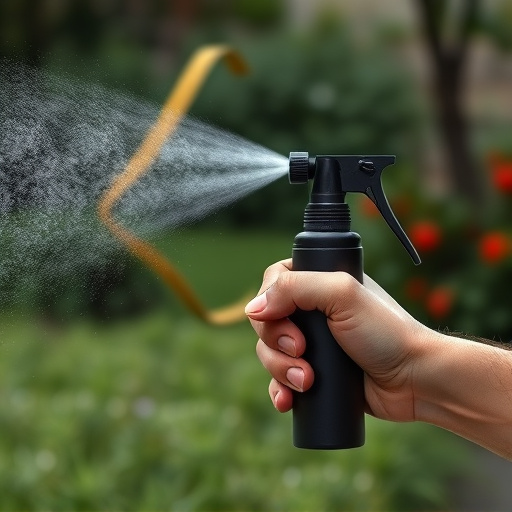Choosing between gel and traditional pepper spray for personal safety involves understanding their distinct applications and legal considerations. Gel sprays adhere to skin, causing pain and temporary blindness, while traditional pepper spray irritates the respiratory system. Both offer non-lethal protection, but local laws vary; users must research and comply with regulations for lawful self-defense. Gel sprays provide targeted protection, reducing accidental harm, while traditional spray deters through respiratory irritation. Gel's viscous nature enhances control in high-stress situations, making it a superior choice for civilian self-defense against wind, water, and close proximity attacks.
In today’s unpredictable world, civilians increasingly seek personal protection tools. One such device gaining popularity is defensive spray. This article delves into the world of defensive spray for civilian use, focusing on two primary types: gel vs. traditional pepper spray. We explore the purpose and legalities surrounding these self-defense mechanisms, dissect the key differences between gel and traditional sprays, uncover the science behind their effectiveness, and emphasize safety considerations in usage and training.
- Understanding Defensive Spray: Purpose and Legalities
- Gel vs Traditional Pepper Spray: Key Differences
- Effectiveness: Science Behind the Spray
- Safety Considerations: Usage and Training
Understanding Defensive Spray: Purpose and Legalities
Defensive spray is a popular self-defense tool among civilians, offering a non-lethal way to deter potential attackers. Understanding its purpose and legal considerations is crucial before considering it as a personal safety measure. The primary goal of defensive spray is to provide a momentary incapacitation, allowing users to escape or gain time to call for help.
When comparing gel versus traditional pepper spray, users should consider the differences in application and effectiveness. Gel sprays are designed to stick to attackers’ skin and eyes, causing pain and temporary blindness, while traditional pepper spray creates a caustic effect upon inhalation, leading to coughing and tears. Both types have their advantages, but legal restrictions vary based on local regulations. It’s essential to research and comply with these laws to ensure responsible and lawful self-defense.
Gel vs Traditional Pepper Spray: Key Differences
In the realm of civilian protection, gel and traditional pepper spray represent two distinct approaches to self-defense. Gel sprays, often hailed as a game changer in personal safety, offer unique advantages over their traditional counterparts. While traditional pepper spray relies on irritants to cause temporary blindness and disorientation, gel formulations incorporate active ingredients that can create a physical barrier on the skin and clothing. This barrier enhances protection by preventing direct contact with the assailant’s eyes, nose, and mouth—areas critical for sensory disruption.
On the other hand, traditional pepper spray has been long-established as an effective deterrent. It operates by causing intense irritation and temporary blindness, providing users with a crucial window of escape. However, its proximity to sensitive areas means that direct contact can result in discomfort or even injury. In contrast, gel sprays offer a more targeted approach, reducing the risk of accidental harm while maintaining high levels of effectiveness against potential threats. Thus, understanding the Gel Vs Traditional Pepper Spray distinctions is vital for folks seeking robust yet safe self-defense options.
Effectiveness: Science Behind the Spray
Defensive spray, particularly gel-based varieties, has emerged as a powerful tool for civilian self-defense. Unlike traditional pepper spray, which relies on capsaicin to cause temporary blindness and respiratory distress in attackers, gel sprays encapsulate capsaicin in a viscous substance. This unique formulation offers several advantages.
The science behind the spray lies in its ability to adhere to an attacker’s skin and clothing, prolonging the effects of the irritant. Gel sprays can create a sticky barrier that traps the attacker, making it easier for the user to escape or seek help. Moreover, gel formulations are less likely to be blown away by wind or washed off by water, ensuring their effectiveness in various scenarios. This makes them a superior choice for civilians seeking protection in unexpected situations.
Safety Considerations: Usage and Training
When considering defensive spray for civilian protection, understanding safety considerations is paramount. Training and proper usage are essential factors to ensure effectiveness and minimize risks. Unlike traditional pepper spray that relies on a fine aerosol mist, gel-based defensive spray offers distinct advantages. The viscous nature of gel makes it easier to target specific areas, reducing the chance of accidental discharge or misapplication.
This is particularly important when civilians use defensive spray in high-stress situations. Gel vs traditional pepper spray debates highlight the former’s ability to provide more precise control, allowing users to aim directly at potential threats. Training programs should emphasize not only how to activate the device but also techniques for optimal application, ensuring maximum impact while minimizing exposure to the user and bystanders.
Defensive spray, especially gel-based options, offers a powerful tool for civilian self-defense. By understanding the science behind its effectiveness, as well as safety considerations and legalities, individuals can make informed choices between gel vs traditional pepper spray. Proper training and responsible usage are key to ensuring these tools serve their purpose without causing harm. Armed with knowledge, civilians can better protect themselves in potential dangerous situations.
